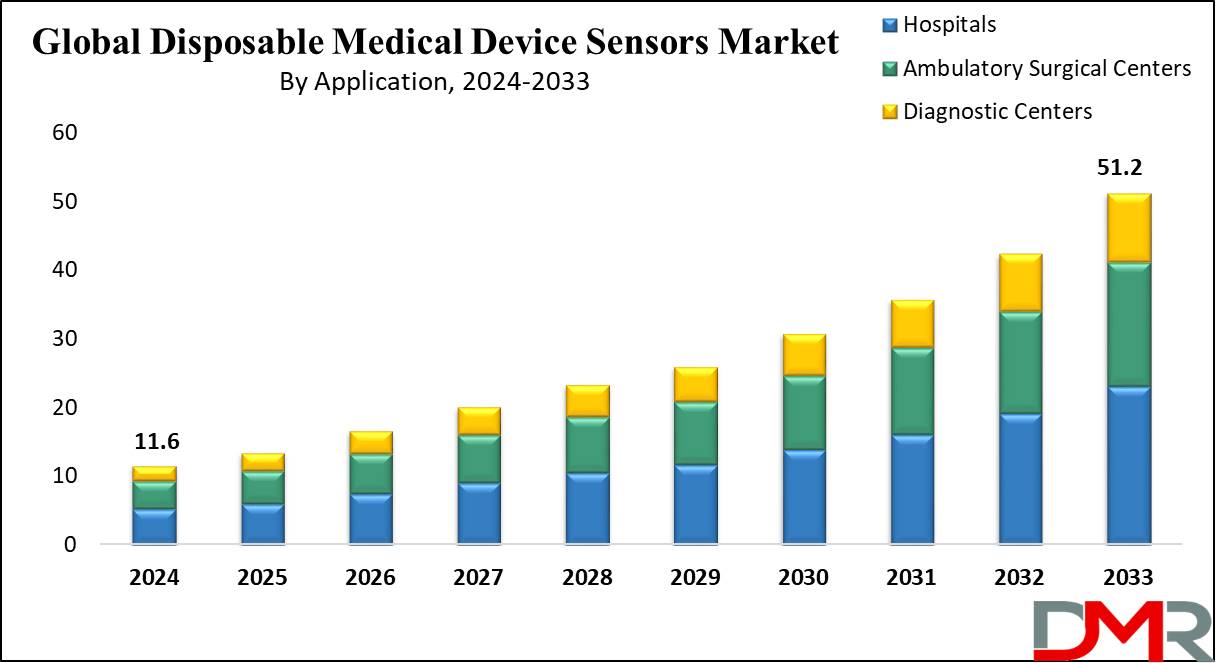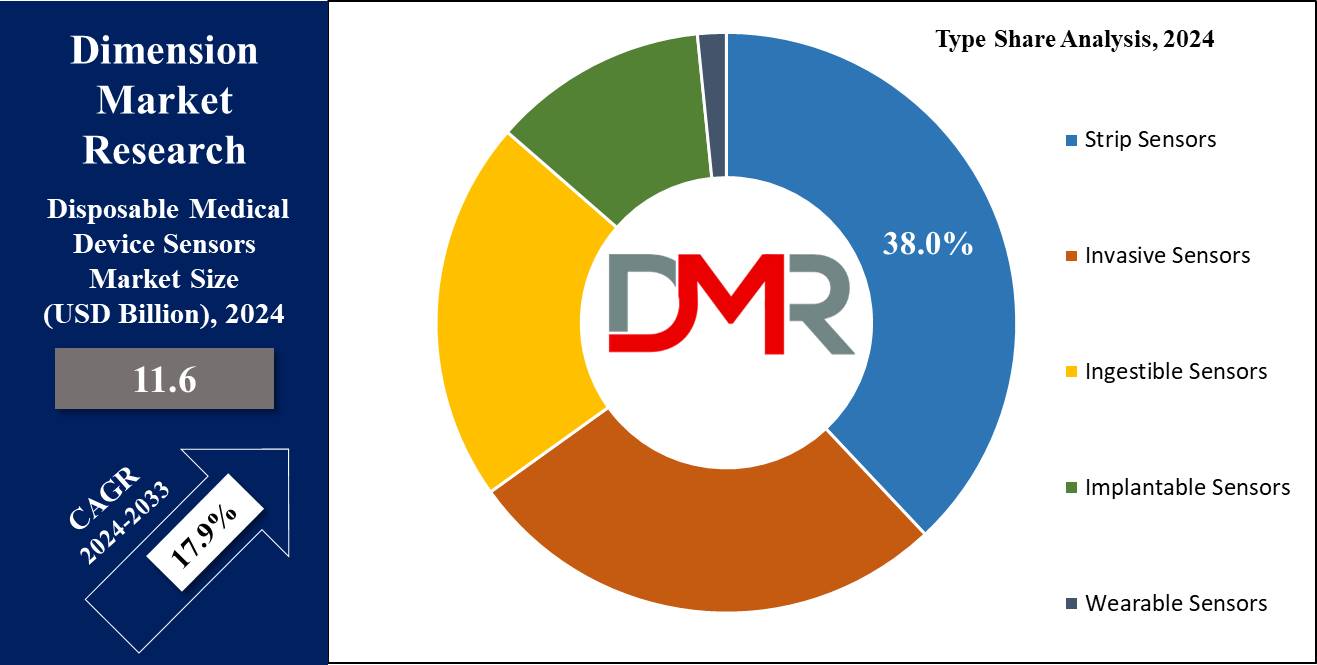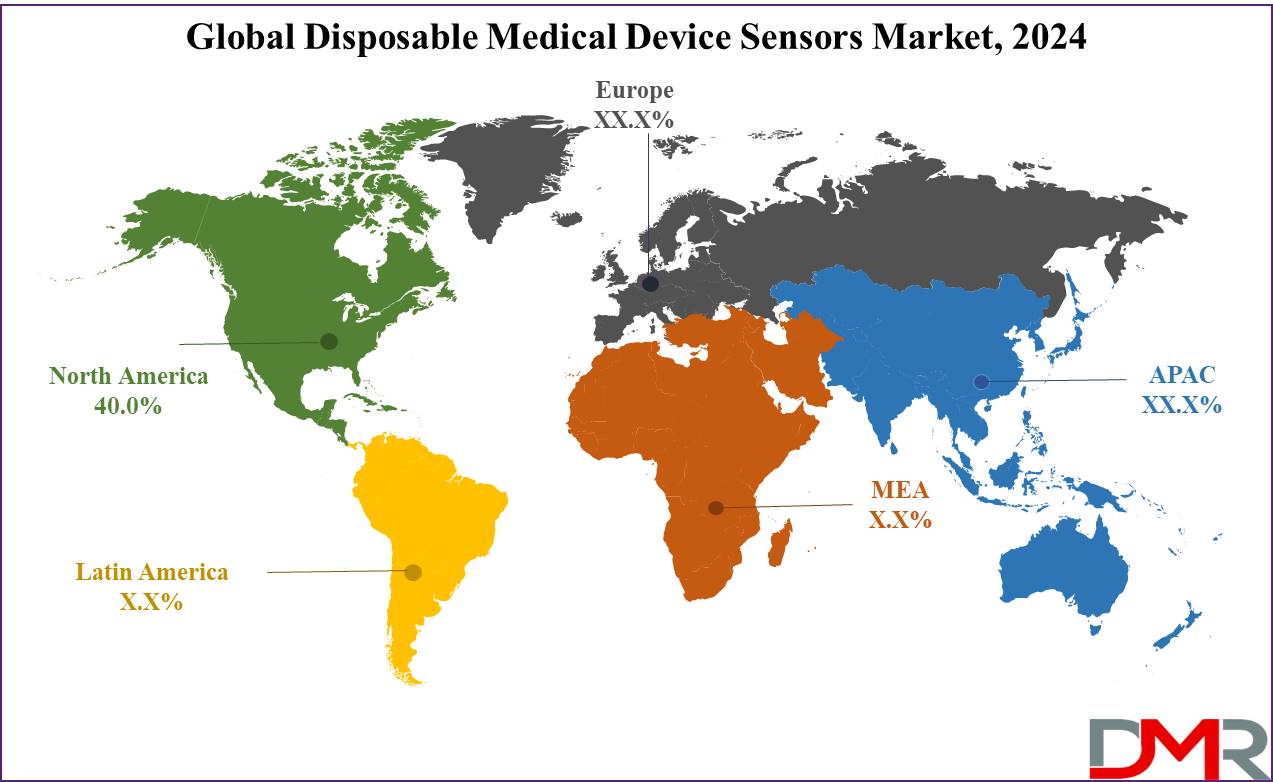Overview
Global Disposable Medical Device Sensors Market size was valued at USD 11.6 Bn in 2023 and it is further anticipated to reach a market value of USD 51.2 Bn in 2033 at a CAGR of 17.9%.

Disposable medical sensors are portable components designed for patient monitoring, diagnostics, and therapeutics. These compact, handheld components facilitate patient observation both directly and remotely by measuring vital signs such as pulse rate, temperature, respiration rate and blood oxygen levels. Disposable sensors have applications across medical specialties including neurology, radiology, ophthalmology and cardiology and their handheld nature allows healthcare providers to track patient health in real-time as well as enhance quality care provision both clinically and non-clinically.
Global Disposable Medical Device Sensors Market report offers an in-depth analysis of the target market, encompassing factual data like market size and shares at both regional and country levels, with CAGR and year-on-year growth rates. The report gives crystal view on market trends, opportunities, restrains and challenges along with competitive landscape analysis. Porters Five Forces, PESTLE, supply-chain analysis, Ecosystem analysis and Macro economic factors are included to cover all the target market aspects.
The research report on the global disposable medical device sensors market includes both qualitative as well as quantitative analysis of the market, company profiles of major market players along with complete product details and their competitive scenario. The report highly exhibits on the current and upcoming market trends and provides comprehensive analysis of all the factors that impact the global disposable medical device sensors market growth and size. The report will help companies to make better strategical business decisions.
Key Takeaways
- Market Size & Share: Disposable Medical Device Sensors Market size was valued at USD 11.6 Bn in 2024 and it is further anticipated to reach a market value of USD 51.2 Bn in 2033 at a CAGR of 17.9%.
- Type Analysis: Wearable Sensors were the clear market leaders in 2024 in terms of disposable medical device sensors market share, accounting for approximately 38%.
- Application Analysis: Hospitals were the leading users of disposable medical sensors in 2024, accounting for roughly 45% of market share.
- Regional Analysis: North America held an approximate 40% global market share for disposable medical device sensors as of 2024.
- Technological Advancements: Innovations in MEMS, nanotechnology, and wireless communication are enhancing sensor accuracy and usability.
- Home Healthcare Growth: The rise in home healthcare and remote patient monitoring is boosting demand for easy-to-use disposable sensors.
- Strategic Collaborations: Partnerships and regulatory approvals are accelerating market growth and product development.
Use Cases
- Patient Monitoring: Disposable medical device sensors are widely utilized in patient monitoring systems, especially critical care settings. These disposable sensors help track vital signs like heart rate, oxygen saturation levels and blood pressure; plus their disposable nature reduces cross-contamination risks between patients - making them ideal for hospitals and clinics.
- Diabetes Management: Disposable glucose sensors are widely used for continuous glucose monitoring (CGM) among diabetic patients. These real-time sensors provide real-time updates on glucose levels, providing better management and timely interventions of diabetes.
- Diagnostic Devices: Disposable sensors are widely utilized in various diagnostic devices, including pregnancy tests, ovulation tests and rapid diagnostic tests for infectious diseases. These disposable sensors offer accurate results quickly while meeting hygiene standards.
- Wearable Health Devices: In consumer health technology, disposable sensors integrated into wearable devices allow consumers to track fitness metrics, sleep patterns, and overall wellness over a shorter timeframe without long-term device usage. These sensors enable individuals to track their health metrics without long-term device commitment.
- Surgical Procedures: For surgical procedures, disposable medical sensors like temperature sensors and single-use electrocardiogram (ECG) leads are utilized to monitor patient parameters. Their disposability ensures no cross-infection occurs, helping maintain a sterile surgical environment.
Market Dynamics
Driver
Chronic diseases and growing demand for home healthcare is one of the major drivers for disposable medical device sensors market growth. As chronic conditions such as diabetes, cardiovascular diseases and respiratory illnesses become more prevalent, there is an ever-increasing demand for continuous monitoring and diagnostics. Disposable medical sensors offer an economical and hygienic solution for monitoring vital signs and other health parameters in both clinical and home settings. Their popularity has been propelled further by increased focus on infection control post-COVID-19; their reduced risk of cross-contamination in hospitals has fuelled greater adoption, further driving demand.
Trend
One notable trend in the disposable medical device sensor market is the adoption of advanced technologies like microelectromechanical systems (MEMS), nanotechnology and wireless communication into disposable sensors for wearable medical devices, leading to more accurate, sensitive, compact sensors which can easily integrate with wearable health monitoring devices such as fitness trackers and smartwatches. Furthermore, personalized medicine's move toward personalized patient monitoring and diagnostics further expands this trend.
Restraints
Despite its advantages, the disposable medical device sensors market faces some barriers that hinder its growth, particularly environmental impacts and waste management issues. Their widespread use contributes to medical waste which poses an environmental concern. Developing and manufacturing these advanced sensors may also be expensive which limits their adoption in low resource settings and reimbursement issues or regulatory hurdles may act as roadblocks to market development.
Opportunities
Remote patient monitoring and telemedicine offer significant growth prospects for the disposable medical device sensors market. As healthcare moves towards more decentralized models, demand for disposable sensors that enable continuous and real-time monitoring outside traditional clinical settings should increase significantly. Emerging markets like Asia-Pacific and Latin America present lucrative growth prospects due to increasing healthcare infrastructure investments and rising awareness of advanced medical technologies.
The COVID-19 Pandemic & Recession: Impact on the Global Disposable Medical Device Sensors Market:
Dimension Market Research has closely monitored the impact of COVID-19 and the recession on specific business segments, along with its short and long-term implications at both the global and regional levels. The initial outbreak of the COVID-19 pandemic caused unprecedented economic damage across numerous regions. The COVID-19 pandemic severely disrupted production, sales, and supply chain activities in developed as well as developing economies. Our report comprehensively covers the pre and post-COVID-19 impacts, along with an analysis of the recession's effects on the global disposable medical device sensors market.
Report Segmentation Analysis
Type Analysis
Wearable Sensors were the clear market leaders in 2023 in terms of disposable medical device sensors market share, accounting for approximately 38%. Wearable sensors are widely utilized across various healthcare applications including monitoring vital signs, fitness tracking and chronic disease management; smartwatches, fitness bands and medical wearables increasingly incorporate wearable sensors for real-time health monitoring in both clinical and home settings - due to rising consumer preferences toward preventive healthcare and fitness this increase has only further fuelled wearable sensor sales.

Other sensor categories such as Strip Sensors, Invasive Sensors, Ingestible Sensors and Implantable Sensors play important roles in diagnostic and therapeutic applications; however, wearable sensors are leading the market due to their versatility, ease of use and growing adoption by both medical and consumer health applications. Furthermore, technological advancements have further solidified wearable sensor's dominance; particularly improvements in sensor accuracy, wireless communication technology and miniaturization.
Application Analysis
Hospitals were the leading users of disposable medical sensors in 2023, accounting for roughly 45% of market share. Hospitals require high-volume, reliable and sterile monitoring devices which help ensure patient safety during critical care, surgeries or routine patient monitoring - such sensors are essential in critical care, surgeries and routine monitoring; their increased prevalence contributes to cross-contamination prevention while increasing hospital admission rates drive this demand for disposable sensors in this setting.
Even though Ambulatory Surgical Centers (ASCs) and Diagnostic Centers contribute significantly to the market, hospitals continue to lead it with their wide array of services and high patient turnover rates. Adoption of disposable sensors has become more widespread as technology improves and infection control becomes an increased focus; with hospitals prioritizing patient safety and monitoring more effectively than ever before this sector should remain dominant over time.
Market Analysis and Research Scope:
We provide Comprehensive insights about the disposable medical device sensors market along with crucial Key factors such as market size, market CAGR, market potential, recent developments, trends, opportunities, new technologies and innovations, recent product launches, restraints and market regulations. This report will help our clients immensely in getting an inside out view of the disposable medical device sensors market by providing them with the complete information about the disposable medical device sensors market and its prominent players with their competitive analysis and strategies.
The global disposable medical device sensors market research report provides accurate estimations for the forecast period 2024 to 2033 based on in-depth research and analysis through rigorous compilation of exhaustive primary and secondary research data. The final data will be carried out after verifying the in-house research analysis by the key opinion leaders of the global disposable medical device sensors market. Our triangulate research method minimizes error margin and gives holistic view on the report.
The Global Disposable Medical Device Sensors Market Report is segmented on the basis of the following:
Type
- Strip Sensors
- Invasive Sensors
- Ingestible Sensors
- Implantable Sensors
- Wearable Sensors
Application
- Hospitals
- Ambulatory Surgical Centers
- Diagnostic Centers
Geographical Segmentation of the Global Disposable Medical Device Sensors Market:
North America held an approximate 40% global market share for disposable medical device sensors as of 2023. This dominance can be attributed to its superior healthcare infrastructure and adoption of cutting-edge medical technologies; rising focus on remote patient monitoring; significant investments in research and development as well as government policies supporting medical device innovation have all helped solidify North America's top position. Furthermore, presence of key market players adds further weight behind their dominance of this field.

Region and Countries
North America
Europe
- Germany
- The U.K.
- France
- Italy
- Russia
- Spain
- Nordic
- Benelux
- Rest of Europe
Asia-Pacific
- China
- Japan
- South Korea
- India
- ANZ
- ASEAN
- Rest of Asia-Pacific
Latin America
- Brazil
- Mexico
- Argentina
- Colombia
- Rest of Latin America
Middle East & Africa
- Saudi Arabia
- UAE
- Israel
- South Africa
- Egypt
- Rest of MEA
The global disposable medical device sensors market research report provides competitive examination analysis of the leading players including company description, SWOT analysis, and financial information, exhaustive product portfolio with specifications, key business areas, market share analysis, acquisitions and mergers, and key developments, etc.
Competitive Landscape:
The global disposable medical device sensors market is highly fragmented due to the presence of several leading players. Prominent market players of the disposable medical device sensors market are exhibiting a keen interest towards the emerging economies such as China, India, etc. to enhance their revenue generating opportunities. The major market players are continuously focusing on their product branding, marketing and expansion of R&D, to increase their customer base. Exhaustive key vendor analysis has been done to meet the ever-changing needs of our clients and provide them with a complete overview on the competitiveness of the global disposable medical device sensors market.
Market Key Players:
- Sensirion
- STMicroelectronics
- Smiths
- Koninklijke Philips
- Medtronic
- Measurement Specialties
- Johnson & Johnson
- Jant Pharmacal
- Honeywell International
- Given Imaging
- Gentag
- GE Healthcare
- Freescale Semiconductor
- Analog Devices
Recent Developments
- Technological Innovations: Enhanced accuracy and miniaturization of sensors, driven by MEMS and nanotechnology, are enabling integration into wearable devices.
- IoT and AI Integration: Sensors now incorporate IoT and AI for real-time monitoring and predictive analytics, improving personalized care.
- Home Healthcare Expansion: Growth in home healthcare has spurred the development of sensors tailored for non-clinical settings, particularly for chronic disease management.
- Sustainability Efforts: Companies are focusing on creating biodegradable and recyclable sensor components to address environmental concerns.
- Regulatory Approvals and Collaborations: New product approvals and strategic partnerships are accelerating innovation and market growth.
Report Details
| Report Characteristics |
| Market Size (2024) |
USD 11.2 Bn |
| Forecast Value (2033) |
USD 46.1 Bn |
| CAGR (2024-2033) |
17.3% |
| Historical Data |
2018 – 2023 |
| Forecast Data |
2024 – 2033 |
| Base Year |
2023 |
| Estimate Year |
2024 |
| Report Coverage |
Market Revenue Estimation, Market Dynamics, Competitive Landscape, Growth Factors and etc. |
| Segments Covered |
By Type (Strip Sensors, Invasive Sensors, Ingestible Sensors, Implantable Sensors, Wearable Sensors) By Application (Hospitals, Ambulatory Surgical Centers, Diagnostic Centers) |
| Regional Coverage |
North America – The US and Canada; Europe – Germany, The UK, France, Russia, Spain, Italy, Benelux, Nordic, & Rest of Europe; Asia- Pacific– China, Japan, South Korea, India, ANZ, ASEAN, Rest of APAC; Latin America – Brazil, Mexico, Argentina, Colombia, Rest of Latin America; Middle East & Africa – Saudi Arabia, UAE, South Africa, Turkey, Egypt, Israel, & Rest of MEA
|
| Prominent Players |
Sensirion, STMicroelectronics, Smiths, Koninklijke Philips, Medtronic, Measurement Specialties, Johnson & Johnson, Jant Pharmacal, Honeywell International, Given Imaging, Gentag, GE Healthcare, Freescale Semiconductor, Analog Devices |
| Purchase Options |
We have three licenses to opt for: Single User License (Limited to 1 user), Multi-User License (Up to 5 Users), and Corporate Use License (Unlimited User) along with free report customization equivalent to 0 analyst working days, 3 analysts working days and 5 analysts working days respectively. |